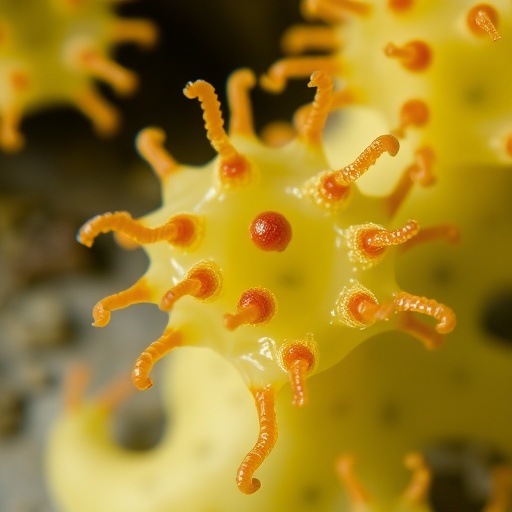A groundbreaking breakthrough emerging from the vibrant marine ecosystems of Okinawa promises to redefine the treatment landscape for leishmaniasis, a devastating parasitic disease afflicting millions globally. Researchers led by Associate Professor Kanami Mori-Yasumoto at Tokyo University of Science have unveiled potent bioactive compounds derived from the marine sponge genus Theonella, demonstrating unprecedented leishmanicidal efficacy paired with a superior safety profile. This discovery could profoundly shift paradigms in neglected tropical disease management, particularly for the approximately 12 million people already affected and hundreds of millions at risk.
Leishmaniasis is caused by unicellular protozoan parasites belonging to the genus Leishmania, with Leishmania major being a primary driver of cutaneous manifestations. This disease induces ulcerative skin lesions that often evolve into disfiguring scars, triggering not only physical but profound psychosocial impacts for afflicted populations predominantly situated in resource-poor settings. Despite its global prevalence across 90 countries, therapeutic options remain woefully inadequate. Existing treatments such as pentavalent antimonials and amphotericin B suffer from notable shortcomings including severe toxicity, complex administration regimens, high cost, and rising resistance among parasite populations.
Amid this challenging therapeutic void, the interdisciplinary team harnessed the chemical diversity of Okinawan marine sponges, known reservoirs of unique secondary metabolites, to identify candidates with promising anti-leishmanial activity. Their focus centered on onnamides, a class of polyketide-peptide hybrid compounds isolated from Theonella species. Through rigorous isolation and characterization protocols, including chromatography and spectroscopic analyses, the researchers purified ten distinct onnamides and structurally elucidated a novel analogue, named onnamide G, expanding the chemical scaffolding available for drug development.
Biological assays employing L. major cultures revealed that several onnamides, particularly onnamide A and its 6,7-dihydro derivative, exert potent parasiticidal effects at nanomolar concentrations. These findings underscore a compelling balance of efficacy and selectivity, with minimal cytotoxicity observed in human cell lines—a critical consideration often undermining the clinical utility of existing medications. Such selectivity suggests a therapeutic window enabling effective parasite clearance without collateral host damage, a long-sought goal in anti-parasitic chemotherapy.
Mechanistic investigations deepened the intrigue by demonstrating that onnamide A’s mode of action diverges markedly from that of amphotericin B. While amphotericin B disrupts parasite viability primarily through binding ergosterol residues in the protozoan cell membrane, onnamide A appears to interact via novel biochemical pathways yet to be fully elucidated. This divergence is particularly relevant in overcoming drug resistance mechanisms that undermine current treatments, positioning onnamide derivatives as promising candidates for second-line or combination therapies aimed at resistant leishmaniasis strains.
The revelation of onnamide G’s structure for the first time offers exciting avenues for structure-activity relationship (SAR) analyses that could illuminate critical functional moieties driving bioactivity. Its unique molecular architecture enriches the chemical space, enabling medicinal chemists to design analogues with optimized pharmacokinetics and pharmacodynamics. These investigations harness cutting-edge spectroscopic techniques—such as nuclear magnetic resonance (NMR) and mass spectrometry—and in silico modeling to predict binding conformations and guide rational synthesis.
Importantly, the natural origin of these compounds inspires sustainable drug discovery pipelines. Dr. Mori-Yasumoto envisions leveraging symbiotic bacteria associated with Theonella sponges to cultivate and biosynthesize onnamides at scale. This bio-farming approach, rooted in marine microbiology and biotechnology, aligns with contemporary emphases on environmentally responsible manufacture, offering a scalable alternative to traditional extraction methods that threaten ecological balance.
In addition to their application against Leishmania, the research hints at broader anti-protozoal potential, encompassing diseases such as Chagas disease and African sleeping sickness—both caused by kinetoplastid parasites bearing biological similarities. The onnamide class’s pronounced activity at low doses suggests improved therapeutic indices and potentially reduced treatment durations, addressing both patient compliance and healthcare system burdens in endemic regions.
Acknowledging remaining hurdles, the team underscores the necessity for expansive in vivo studies and detailed pharmacokinetic profiling to translate these promising leads from bench to bedside. Critical assessments will include absorption, distribution, metabolism, excretion (ADME) properties, and efficacy in relevant animal models to establish safety and therapeutic viability, alongside evaluation of cost-effectiveness essential for adoption in low-resource settings.
Further support for this research arises from the AMED Drug Discovery Booster program, a Japanese initiative fostering translational efforts to expedite promising compounds toward clinical trials. Such backing highlights Japan’s growing leadership in addressing neglected tropical diseases through innovative natural product research, integrating chemical biology, pharmacology, and marine sciences.
Statements from co-researchers affiliated with the University of the Ryukyus emphasize the immense untapped biological wealth of Okinawan waters. Their commitment to discovering “seeds of medicine” underscores a broader strategic vision: utilizing local biodiversity for global health gains while confronting evolving challenges like pathogen resistance head-on. This convergence of marine biology and infectious disease research exemplifies multidisciplinary innovation vital for future therapeutic breakthroughs.
In summary, the identification of onnamides and their analogues as potent, selective leishmanicidal agents marks a pivotal advancement in infectious disease pharmacology. By capitalizing on marine sponge-derived natural products, this research lays foundational steps toward the development of safer, more effective treatments against a disease long neglected by mainstream drug discovery. Should ongoing preclinical validations succeed, onnamide-based therapies could revolutionize clinical management of leishmaniasis, offering new hope to millions and carving a path for similar approaches targeting other parasitic afflictions.
Subject of Research: Animals
Article Title: Onnamides and a Novel Analogue, Onnamide G, as Potent Leishmanicidal Agents
News Publication Date: 5-Sep-2025
Web References:
https://link.springer.com/article/10.1007/s10126-025-10494-1
References:
DOI: 10.1007/s10126-025-10494-1
Image Credits:
Credit: Dr. Kanami Mori-Yasumoto from Tokyo University of Science, Japan
Keywords:
Health and medicine, Leishmaniasis, Infectious diseases, Medical treatments, Parasitic diseases, Drug resistance, Tropical diseases, Drug discovery, Marine biology, Pharmaceuticals




